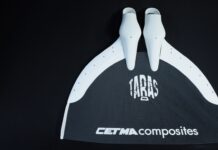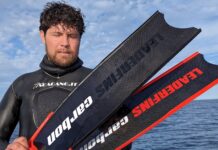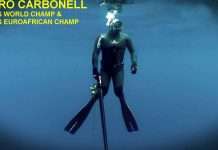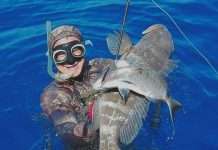The seabass
One of the most common first catches for the rookie spearo is the seabass. Almost all of us remember the catch of our first seabass, just as the first kiss of our girlfriend when kids. I was 15 and was diving on the external part of a dam that protected a small bight, with fast current bringing clear and cold water towards the harbour, in Corsica. The seabass that unluckily found itself in the trajectory of my small three points spear (of a Technisub Grinta 60 given to me by my dad for the promotion at school) was almost still, apart from small movements of the pectoral fins, in half a meter of water among the rocks of the dam in a torrid August morning.
When and where to find it
The frequent situations when seabass is easy to catch are determined by the fact that often its behaviour is predictable. You can find the seabass both alone or in big shoals; it lives in different kinds of habitats, but mainly in areas near harbours and ports, breakwater dams and fresh or slightly salty waters of the lagoons. It ascends long parts of rivers and moves hunting small fish, shellfish and clams. The seabass follows tides and variable water temperatures, from the estuaries to the sorrounding coasts, but keeping its position generally in areas where water is no deeper than 15 meters. Today I hunt seabasses mainly in Winter, from December to March. When water temperature goes below 16°C these fish react moving towards the sea, liking shallow and slowly degrading sea bottoms, often finding home in areas with posidonia and rich of small fish.
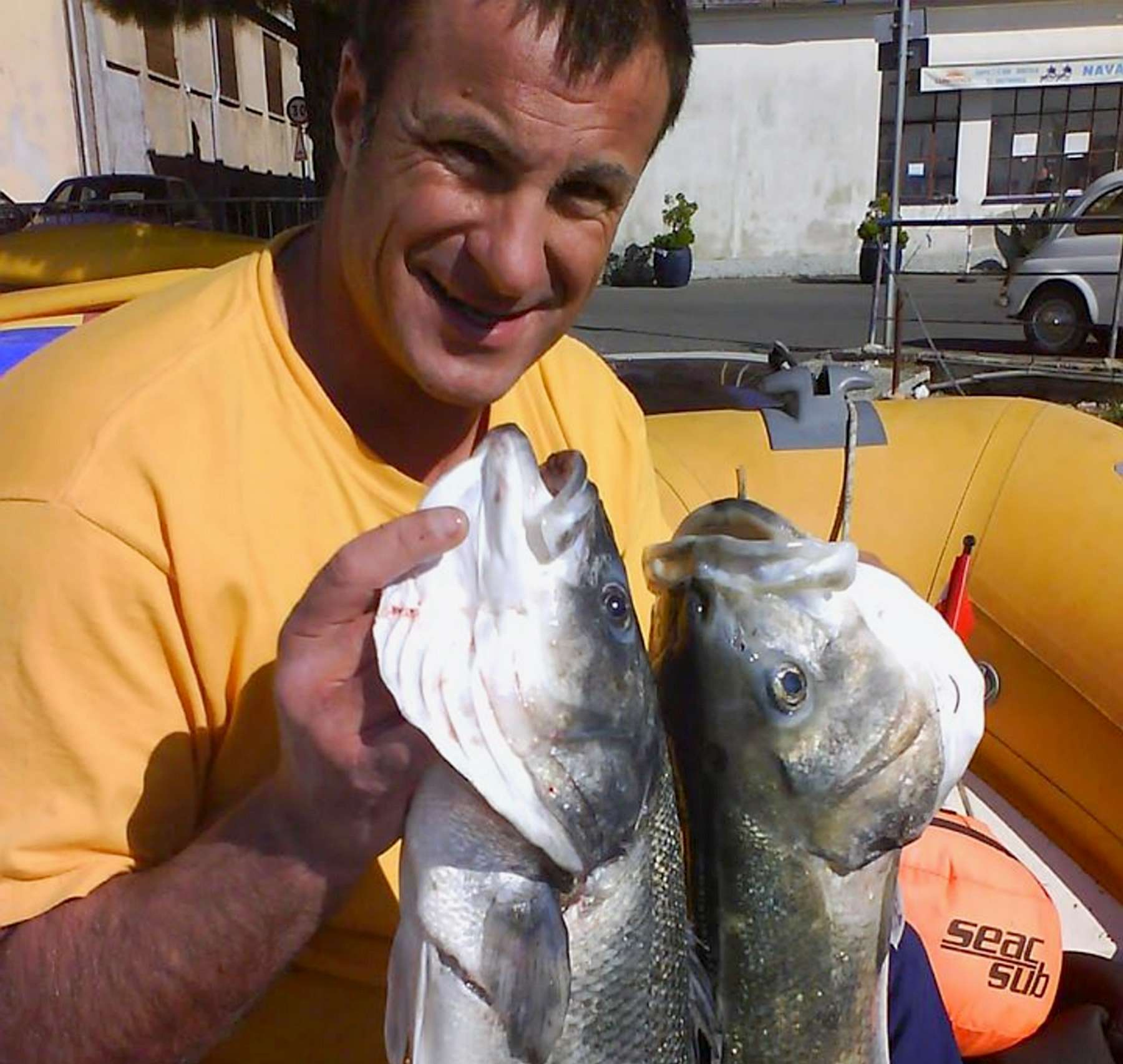
Spearfishing technicque: aspetto
Seabasses can be caught with aspetto (waiting) technicque or ambush in the lair. Aspetto will require one single important characteristic: total immobility. The best habitat will be the one richer of small prey fish. Rocks at the surface, hit by waves and currents, are a catalyst to seabass. Passages and channels with current passing through, tips of waterbreaking dams, relics, even small ones on sandy floors at low depths and close to rivers, are also perfect spots. In case of cold calm Winter sea, with no noise coming from the waves hitting the rocks, seabass react to noise recalls. These predators are curious and, in case the area is not full of human beings, they can come close to the spearo even if the latter is not at all hidden, and the fish can even come back after a missed shot. A hit with the hand on the water surface before the dive, or even a small stone thrown in very clear and calm water can recall fish. Recently very effective have been also clickers, that have substituted the tick sound made by hitting constantly with a stone a rock underwater when waiting perfectly still.

Spearfishing technicque: ambush
More often in Winter, but also in any season, seabass love to rest in wide caves. In my area in the smallmislands of Palmaria and Tino (Portovenere, Liguria, Italy), seabass gather in big caves among the rocks on the coast of the islands or lairs with various openings made of huge rocks on the sea bottom. To the wide openings of these caves one must approach with a mimetic route, using the ambush technique. Without disturbing the fish in their back and forth from the lair, we will bring forward the first ambush stopping just outside the passage in the rocks, stimulating the curiosity of the fish simply with our presence, and after with small recalls. Evidently, the know-how gathered in previous occasions will help us preview the shape and width of the lair, but most of all the positioning of the seabasses inside it, determining our movements and action. In long and deep cavesi t could be possible to achieve multiple catches. On the other hand, if we will undertand our chance will be of a single shot, it will be advised to enter the cave in a slow motion until we will see the shoal of fish, generally quite calm, that will be swimming slowly in a circular trajectory in the shadow. Only in such a way we will be able to select the prey and proceed in our action, which will depend basically on the capacity of not alerting the shoal. For such kind of action and shot, which needs speed and good aiming to long and thin shapes, brandishing will be important, so I prefer a 90 cm sling gun with thin barrel, 16 mm diameter single elastic band and 6 mm diameter shaft, which is light and extremely fast.
Times for the hunt
The hunting and movement of the seabass is demonstrated to be high when the tide grows and reaches its highest point. It is so important to plan the spearfishing aspetto activity looking at high tide in the early morning or dawn. Last December I was in an area with rocks going up to the surface and away from the coast, in a sea floor going immediately down to – 15 meters. It was Sunday and many spearos had already passed by the same area, which is known for the presence of seabasses. In the cold of dawn, in an almost spectral atmosphere, we were 3 in the same zone. Time was good with peak of the tide and good presence of seabasses. After a couple of catches in the very shallow water among the rocks and channels created between them, where a light current was present, a good habitat for seabass, I made a big difference in the final result for a very simple reason: I have tried to get out of the traditional scheme of waiting technique in shallow water and have looked for the seabasses in more turbid water of the freezing Winter dawn, finding the predators swimming at the base of the submerged landslide. They were alarmed, but continued to swim around hunting just close to the big rocks full of small preys.
Gabriele Delbene
Gabriele Delbene, year ’66, born inLa Spezia, Liguria, Italy, is a great Spearfishing Champion, who has reached important results in International competitions. Gabriele has also a degree in Osteopathy and Physical Education and inventor of the “global ascent manouvre”.
Main spearfishing titles
Bronze medal at 2018 World Championship for Clubs, Biserta, Tunisia
World and European Teams Vice.Champion
Winner of 5 International trophies
World Record Abyssal Spearfishing (- 62,4 meters)
Stage by Gabriele Delbene
Gabriele today organized extremely intersting, useful and deep spearfishing stages, that he describes this way: “Spearfishing, as any other human activity, can be taught. The experience of a spearfishing stage needs great effort, buti s also strongly educational. Stage is organized with maximum 4 people and for such reason it is thought to define and solve individual technical issues. Important focuses are aimed to working on the breathing of the spearo, who has different needs compared to the freediver, to optimize performance still maintaning the hoghest elvel of safety. All work is focused on spearfishing, si entrance tests, spearfishing actions of the student, commented video during the technical point in the evening in front of a wide tv screen, lessons applied to the episodes and encounters of the day, all are part of the experience that strongly and quickly improves statistics of sighting of fish, and so consequent catches.
Contacts:
email: gabriele.delbene@libero.it
mobile: +39 3339598374



